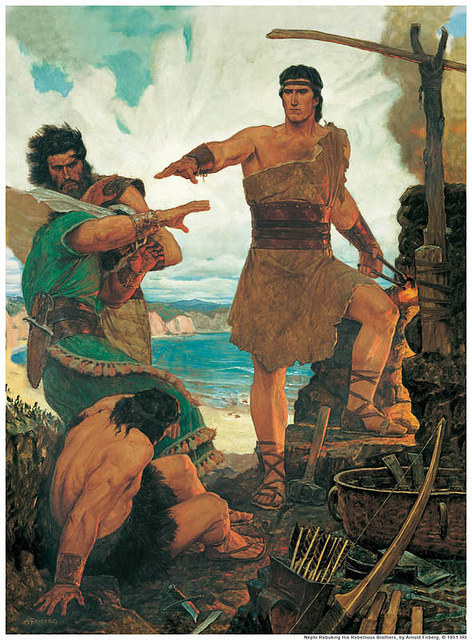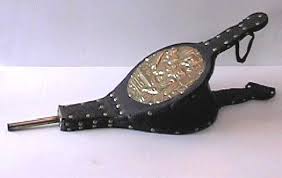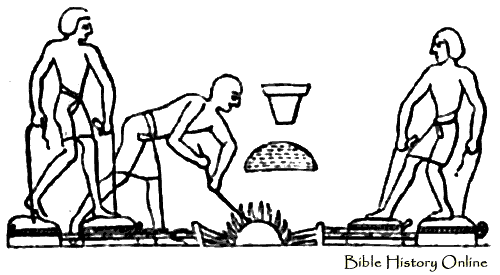Bellows Or Bellowses
[Another Book of Mormon Error OR Not?]
prepred by Don R. Hender
English is a language of rules and
exceptions to those rules. And often lost in that mechanics of being most
grammatically correct is the very essence of communitive meaning. Such seems
to be the case of the actual 'error' in the Book of Mormon of the use and
meaning of the word 'bellows' or ought I say 'bellowses'. Certainly any well
versed Grammarian can easily detect which is the proper English term to be used
and which is not. In the 1830s, when the language was still developing and
deciding what was and what was not genreally acceptable English, it may well
have not been so clearly cut and determinable. And yet this 'error' may not
even be directly associated and justifiable by the rules of English at all,
but rather by the bottom line actual communication, that is in actual
communitive meaning.
In the 1830 original edition of the Book of Mormon, when it spoke of Nephi
overseeing the building of their ship, it states, "And it came to pass that I,
Nephi, did make bellowses wherewith to blow the
fire, of the skins of beasts; and after that I had made bellowses, that I might have wherewith to blow the
fire, I did smite two stones together, that I might make fire; . . .". Of
course any properly read English Grammarian would easily come to find fault
with the use of the 'improper' word form of 'bellowses'. For whether singular
or plural, the proper word is 'bellows', one bellows or forty and one
bellows, the word is just 'bellows'. Albeit, in some extrodinary cases
if the singular form of a word ends with an 's', to make it plural, you then
do add an additional 'es', thus 'ses'.
One such exception is in the technical use** of the word 'moss'. Now generally
'moss' is 'moss', whether you have a little or a lot, singular or plural.
But in a technical usage when speaking of a variety of differing species of
moss, such a group of several different species of moss, it is most properly
spoken of as 'mosses'. That is, 'we have thirty different species of mosses'.
And that is proper English.
Now with that perspective, lets us now again consider the case of bellows and
bellowses. When confronted 'critically' about the use of the first edition
word of 'bellowses' in the 1830 edition of the Book of Mormon, it became a
very 'easy' matter to switch to the 'proper English' form of 'bellows'. And
thus in every subsequent edition, including the very latest and greatest
edition of the Book of Mormon it now reads, 'And it came to pass that I, Nephi,
did make a bellows wherewith to blow the fire,
of skins of beasts; and after I had made a bellows,
that I might have wherewith to blow the fire, I did smite two stones together
that I might make fire." (2 Nephi 17:11) Now that is good English, right?
 But does it contain Nephi's true and proper meaning? In perhaps the most
famous art picture of Nephi buiding the ship, it shows Nephi with the
typical single over head wooden handled type bellows which the smith pulls
down upon to force the singular bellows to blow air upon the fire. And thus
the art work gives the impression of Nephi working alone in smelting the
ore and forming the tools with which to build the ship, right? But this
contradicts the Book of Mormon account wherein Nephi pleads with his brothers
But does it contain Nephi's true and proper meaning? In perhaps the most
famous art picture of Nephi buiding the ship, it shows Nephi with the
typical single over head wooden handled type bellows which the smith pulls
down upon to force the singular bellows to blow air upon the fire. And thus
the art work gives the impression of Nephi working alone in smelting the
ore and forming the tools with which to build the ship, right? But this
contradicts the Book of Mormon account wherein Nephi pleads with his brothers
 that they must 'help' him build the ship and perform the work. Actually the
artist's depicted overhead operated bellows was not the common form of bellows
in use in the day and time of Nephi. Nephi's bellowses are kind of like the
simple common form of a bellows seen here at the left which Nephi would have used,
though it only comes close in some conceptual ways. As noticed, this hand pump
bellows has a long nozzel leading from the bellows air sack which allows
a distance to be maintained from the human limb operation of the bellows
far from the nozzle's delivery 'spout'. And the air is thus 'forced' with
a great multiplication of wind force out from the enlarged bellows' sack
and down into and through the extremely narrowing nozzle's small size. This
would mean that the 'air wind' is forcefully feeding the fire's flame and '
intensifiying the fire's heat. Now consider multiplying that forced air flow
by say six or eight times rather than just having one such bellows feeding
the fire.
that they must 'help' him build the ship and perform the work. Actually the
artist's depicted overhead operated bellows was not the common form of bellows
in use in the day and time of Nephi. Nephi's bellowses are kind of like the
simple common form of a bellows seen here at the left which Nephi would have used,
though it only comes close in some conceptual ways. As noticed, this hand pump
bellows has a long nozzel leading from the bellows air sack which allows
a distance to be maintained from the human limb operation of the bellows
far from the nozzle's delivery 'spout'. And the air is thus 'forced' with
a great multiplication of wind force out from the enlarged bellows' sack
and down into and through the extremely narrowing nozzle's small size. This
would mean that the 'air wind' is forcefully feeding the fire's flame and '
intensifiying the fire's heat. Now consider multiplying that forced air flow
by say six or eight times rather than just having one such bellows feeding
the fire.
 In reality the actual 'ancient bellowses' of Nephi's day were not that of
one 'bellows' in the singular. What was used in the smelting of ore and thus
the forming and making of tools does meet the exact conceptual expression of
having to have the help and aid of many workers (brothers) together to
operate a number of different pairs of foot bellowses together with a
'pit manager' in control of the smelting of the ore. An earthen 'pit smelter'
was formed in the ground and was surrounded by a number of sets of foot
'bellowses' opperated simutaneously together as depicted in the simple drawing
at the left. At the Timnah mines and Elath smelters of Ezion-Gebber, Nephi and
his brothers would have seen, if not also participated in, just such a number
of several sets of foot bellowses about a central pit smelter process.
In reality the actual 'ancient bellowses' of Nephi's day were not that of
one 'bellows' in the singular. What was used in the smelting of ore and thus
the forming and making of tools does meet the exact conceptual expression of
having to have the help and aid of many workers (brothers) together to
operate a number of different pairs of foot bellowses together with a
'pit manager' in control of the smelting of the ore. An earthen 'pit smelter'
was formed in the ground and was surrounded by a number of sets of foot
'bellowses' opperated simutaneously together as depicted in the simple drawing
at the left. At the Timnah mines and Elath smelters of Ezion-Gebber, Nephi and
his brothers would have seen, if not also participated in, just such a number
of several sets of foot bellowses about a central pit smelter process.
Nephi would have made any number of sets of foot bellowses, one set
per bellows worker. And while the simple graphic shows but two bellowses
workers, the actual arrangement allowed for 4 or more men to surround the pit
smelter and for each of them to operated a set of foot bellows to feed and
intensify the pit fire's flame and heat by the enhanced forced air flow.
Indeed Nephi did need the aid of his brothers in not only building the ship
but from the very start of the making of the metal tools to begin with.
Now as to the question of the Book of Mormon 'error'. Was the use of the
word 'bellowses' incorrect or was it a
matter of a dialect preference or was it
an out growth from translation from a language where there were two different
forms of the word denoting one as singular and the other as plural? Yes, probably,
it is likely some such cause or even a combination of such, as the weakness of
the one word to cover both singular and plural cases has lead to a misconception
error in our Book of Mormon of today. Certainly at the least, if not the more
expressive and much better communicative word is 'bellowses', which would
or could be used to correct the conceptual error in today's texts, which would
be accordingly better corrected to read, 'I, Nephi, did make several
sets of foot bellows [bellowses].'
** Technical Writing. There are some 'exceptions' which even the grammarians do not
account for. In the fields of Science and Technical writings, they can and do have
their own set of 'exceptions' to the Grammar rules of English. Standard grammar will
state that the word 'moss' is both singluar and plural and that the uses of making 'moss'
plural by adding the addition of 'es' on the end of the word is incorrect as 'moss' is
already plural. But in technical or scientific writing their is a case of 'exception'
made so that the technical writers can communicate with greater understanding. That is
in the case where there are different 'species' of moss, to properly denote that fact
he scientific writer with used the word 'mosses' indicating not that there is just a lot
of moss/plural but there is in fact a matter of speaking to the larger scheme of the
fact that there are numerous different types and species of 'mosses!'
Thus if in the original 1830 Book of Mormon there was more to communicate than the fact
that Nephi made a number of bellows meaning plural in number, such as the fact that Nephi
constructed several different 'types' of bellows, hand, foot, pull/push bellowses of
varying types, then in the sense of communicating that 'technical fact' then it would
be a technical writing exceptions to uses 'bellowses' to denote that there were such
different types of bellows beyond just many of the same singl type in simple plural use.
[I would have to consider that the Reformed Egyptian language, if not the
Hebrew also, would have had two forms of the word bellows, one a singular
form and another a plural form, perhaps something like 'bellows' and
'bellowsim'. And when so translating a language, if the form being translated
IS NOT the 'singular' form then certainly an added 'es' after an 's' would
comply with the general English rule of making such a singular word into a
plural form. So just where is or was the 'error' and which gives the most
accurately communicative form of the meaning being conveyed? Certainly the
weakness in the English language not to have two forms of the word, one
singular and the other plural, is partly in itself to blame here.]
rev. 9 October 2018
|